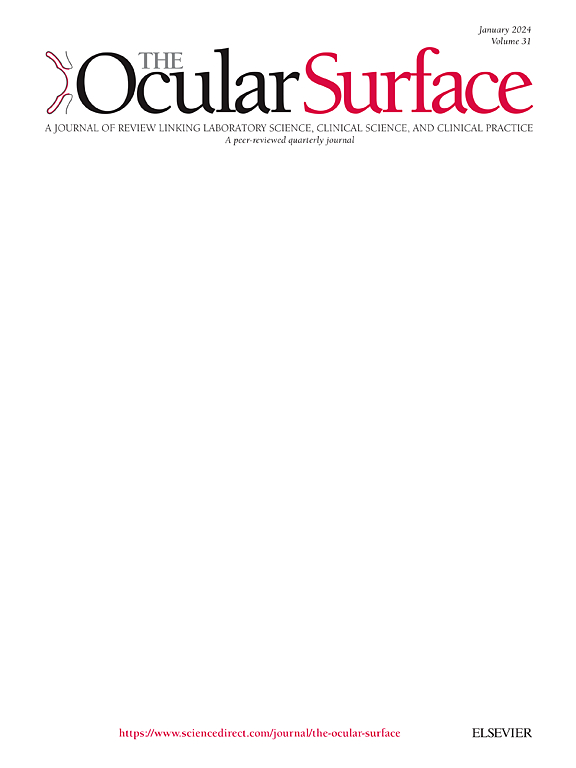前列腺素F2α通过激活RhoA/ROCKs信号通路,促进泪腺纤维化进展,从而加重干眼症
IF 5.6
1区 医学
Q1 OPHTHALMOLOGY
引用次数: 0
摘要
探讨干眼症(DE)患者前列腺素F2α (PGF2α)的表达及其与临床表现的相关性,探讨干眼症的发病机制。本文章由计算机程序翻译,如有差异,请以英文原文为准。
Prostaglandin F2α exacerbated dry eye by promoting lacrimal gland fibrosis progression through the activation of the RhoA/ROCKs signaling pathway
Purpose
To investigate Prostaglandin F2α (PGF2α) expression in dry eye (DE) patients and its correlation with clinical manifestations, exploring potential mechanisms in DE.
Methods
Cross-sectional case-control study including 21 DE patients and 16 controls. PGF2α levels were detected by ELISA (Enzyme-linked immunosorbent assay). Correlation analyses were conducted between PGF2α in human tears and DE symptoms (The Ocular Surface Disease Index, OSDI) or signs including tear film breakup time using fluorescein sodium strips (FBUT), Schirmer Ⅰ test (ST) and corneal fluorescein staining (CFS). Dry eye models were induced using scopolamine and desiccating stress, with transcriptomic sequencing to analyze differential gene expression. DE mice were treated with the PGF2α receptor inhibitor AL8810. Various assays (Oregon green dextran staining, phenol red thread test, PCR, immunofluorescence, MASSON staining, ELISA, Western Blot) evaluated DE phenotypes, lacrimal gland inflammation, and fibrosis.
Results
DE patients had significantly elevated PGF2α levels, negatively correlating with ST and positively with CFS. DE mice showed increased PGF2α and FP receptor expression in lacrimal glands, decreased tear production, worsening ocular surface damage, and elevated inflammation and fibrosis. The TGFβ1/Smads and RhoA/ROCKs pathways were activated, with changes becoming more pronounced with extended molding time. AL8810 reduced fibrosis, partially restored tear secretion, and alleviated corneal damage while inhibiting RhoA/ROCKs pathway activation without affecting TGFβ1 expression.
Conclusions
PGF2α exacerbated DE by promoting lacrimal gland fibrosis progression via the RhoA/ROCKs signaling pathway. Inhibiting PGF2α receptors effectively suppressed the progression of dry eye and lacrimal gland fibrosis, which may offer a promising therapeutic strategy for DE, particularly in refractory cases associated with lacrimal gland fibrosis.
求助全文
通过发布文献求助,成功后即可免费获取论文全文。
去求助
来源期刊

Ocular Surface
医学-眼科学
CiteScore
11.60
自引率
14.10%
发文量
97
审稿时长
39 days
期刊介绍:
The Ocular Surface, a quarterly, a peer-reviewed journal, is an authoritative resource that integrates and interprets major findings in diverse fields related to the ocular surface, including ophthalmology, optometry, genetics, molecular biology, pharmacology, immunology, infectious disease, and epidemiology. Its critical review articles cover the most current knowledge on medical and surgical management of ocular surface pathology, new understandings of ocular surface physiology, the meaning of recent discoveries on how the ocular surface responds to injury and disease, and updates on drug and device development. The journal also publishes select original research reports and articles describing cutting-edge techniques and technology in the field.
Benefits to authors
We also provide many author benefits, such as free PDFs, a liberal copyright policy, special discounts on Elsevier publications and much more. Please click here for more information on our author services.
Please see our Guide for Authors for information on article submission. If you require any further information or help, please visit our Support Center
 求助内容:
求助内容: 应助结果提醒方式:
应助结果提醒方式:


